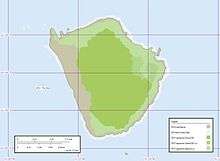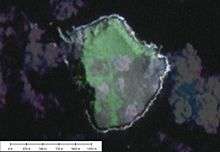ʻAta
ʻAta is a small, rocky island in the far south of the Tonga archipelago, situated on 22°20′30″S 176°12′30″W / 22.34167°S 176.20833°W. It is also known as Pylstaart island. It should not be confused with ʻAtā, which is an uninhabited, low coral island in the string of small atolls along the Piha passage along the northside of Tongatapu, nor should it be confused with Ata, a traditional chiefly title from Kolovai.
Myths
Although ʻAta must have been known to Tongans from times immemorial, as it features in old myths, it may have been mixed up with ʻAtā, and it is alleged not to have been remembered until the Tongans were told about it by the Europeans. In fact the following myth is rather from the original Tongans in the Lau Islands (Fiji) than from Tonga proper itself.
According to these myths it was, together with ʻEua the first island hauled up by (one of) the Maui brothers from the bottom of the sea. Having not much experience in this type of fishing yet, these two islands became quite hilly. It had originally 7 hills, but Maui stamped on the highest mountain until it was flattened into its surrounding valleys, and he did likewise with the next mountains. By the time only 3 hills were left over he was weary and went away. With the following islands he hauled up, starting with Tongatapu, he was more careful to keep them flat. The sub-god Laufakanaʻa was the first ruler of ʻAta.
History
The first European to discover ʻAta was Abel Tasman on 19 January 1643. Because of the many tropic birds he saw near the island, he gave it the name of Pylstaert Eylant or in modern Dutch Pijlstaart, meaning arrowtail, an apt description for, and in that time the name of the Tropic Bird. Adverse winds prohibited him from coming closer and no natives coming to him in their canoes were seen either. From his vantage point (looking towards the northeast), the shape of the island resembled to him the breasts of a woman.
The island is recognized by Cook during his second voyage, and its coordinates were corrected by Lapérouse who referred to the island as île Plistard.
ʻAta has the dubious honour to be one of the three islands in Tonga to have been affected by the Peruvian slavetrade of 1862 to 1864, and to be the one which suffered most.
In 1862 the Peruvian government had decided to obtain indentured labourers to collect guano on the Peru's Chincha Islands. A fleet of ships spread out over the Pacific to find willing migrants, but quickly switched to plain kidnapping tactics instead. In June 1863 about 350 people lived on ʻAta in a village called Kolomaile (of which remnants were still visible a century later). Captain Thomas James McGrath of the whaler "Grecian", having decided that slavetrade was more profitable than whaling, came along and invited the islanders on board for trading. But once almost half of the population was on board, doors and rooms were locked, and the ship sailed away. 144 persons would never return. The "Grecian" tried to get more recruits from the Lau group, but was not successful there. From Niuafouʻou it was able to fool only 30 people; the second island in Tonga to be affected. (ʻUiha was the third, but there the islanders had actually been able to reverse roles and ambushed the ship the "Margarita" instead).
The "Grecian" never made it to Peru. Probably near Puka-Puka in the Tuamotus it met another slaver, the "General Prim", which had left Callao in March, which was more than willing to take over the 174 Tongans to quickly return to port, where it arrived on 19 July. Meanwhile, however, the Peruvian government, under pressure from foreign powers and also shocked that its labour plan had turned into a slavetrade, had already on 28 April cancelled all licenses. The islanders on board of the "General Prim", and other ships were even not allowed to enter Peruvian soil. They were transferred to other ships chartered by the Peruvian government to bring them home. By the time, 2 October 1863, the "Adelante" (on which the Tongans were put) finally left, many had already died or were dying from contagious diseases. It seems that Captain Escurra of the "Adelante" (which had been one of the most successful slavers before!) had not any intention to bring them home after being paid $30 per head. Instead he dumped them on uninhabited Cocos Island, (absolutely not on the route to Tahiti), claiming that the 426 kanakas were affected with smallpox and a danger to his crew. 200 were left over there when the whaler "Active" passed along and found them on 21 October. Somewhere in November finally a Peruvian warship "Tumbes" came to save the survivors, of which there were 38 left. They were brought to Paita, where they apparently were absorbed in the local population.
Meanwhile, in Tonga, king George Tupou I, having heard of the happenings, sent three schooners to ʻAta to evacuate and to resettle the about 200 remaining people to ʻEua, where they would be safe against future attacks. Nowadays their descendants still live in Haʻatuʻa of which a part has received the name Kolomaile. Their wish ever to return to ʻAta was still much alive in the mid 20th century. But it is not likely to happen, as the island does not have a harbour, making shipping to it a dangerous and uneconomical adventure.
Currently ʻAta, still part of the kingdom of Tonga, remains uninhabited.
In 1965 six Tongan youths, Sione Fataua,17, Fatai Latui,17, Tevita Fifita Sioloa,15, Kolo Fekitoa,17, Mano Fotau,16 and Luke Veikoso (later a boxing champion),16, were shipwrecked on 'Ata for 13 months. They lived off the land on this waterless island until rescued by the Australian fishing boat, Just David (Tevita), under its skipper John Derrick.
References
- L. Fison, Tales from Old Fiji; London 1907
- E.W. Gifford; Tongan myths and tales; BPB bulletin 8, 1924
- H.E. Maude; Slavers in paradise; ANU 1981, ISBN 0-7081-1607-8
- Keith Willey;"Naked Island",Hodder and Stoughton,Sydney,1970, ISBN 0-340-12603-5

